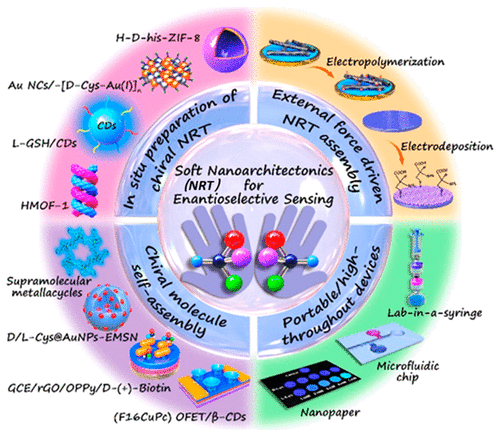当前位置:
X-MOL 学术
›
Acc. Chem. Res.
›
论文详情
Our official English website, www.x-mol.net, welcomes your feedback! (Note: you will need to create a separate account there.)
Soft Nanoarchitectonics for Enantioselective Biosensing.
Accounts of Chemical Research ( IF 18.3 ) Pub Date : 2020-02-19 , DOI: 10.1021/acs.accounts.9b00612 Jing Liu 1 , Hong Zhou 1, 2 , Wenrong Yang 1 , Katsuhiko Ariga 3, 4
Accounts of Chemical Research ( IF 18.3 ) Pub Date : 2020-02-19 , DOI: 10.1021/acs.accounts.9b00612 Jing Liu 1 , Hong Zhou 1, 2 , Wenrong Yang 1 , Katsuhiko Ariga 3, 4
Affiliation

|
Chirality is a fundamental property of a molecule, and the significant progress in chirality detection and quantification of a molecule has inspired major advances in various fields ranging from chemistry, biology, to biotechnology and pharmacology. Chiral molecules have identical molecular formulas, atom-to-atom linkages, and bonding distances, and as such they are difficult to distinguish both sensitively and selectively. Today, most new drugs and those under development are chiral, which requires technological developments in the separation and detection of chiral molecules. Therefore, rapid and facile methods to detect and discriminate chiral compounds are necessary to accelerate advances in many research fields. The challenges in analysis stem from the obvious fact that chiral molecules have the same physical properties. Although significant progress on the detection of enantiomeric composition has been achieved in the past decade, in order to fully realize the capacity of chiral molecular interrogation, highly sensitive and selective, portable, and easy-to-use detection remains challenging because of the limitation of conventional techniques.Soft nanoarchitectonics is a new concept for the fabrication of functional soft material systems through harmonization of various actions including atomic/molecular-level manipulation, chemical reactions, self-assembly and self-organization, and their modulation by external fields/stimuli. Soft nanoarchitectonics has been widely used as a key enabling technology for integrating predefined molecular functionalities including electrochemical, optical, catalytic, or biological properties into biosensing devices, which provides exciting opportunities to design, assemble, and fabricate tailored nanosystems to enable new sensing strategies for chiral molecules.In this Account, we aim to concisely discuss how these molecule-inspired soft nanoarchitectonics work for enantioselective sensing. We will first outline the basic principle and mechanistic insights of the soft nanoarchitectonics approach for enantioselective sensing, and then we will describe the new breakthroughs and trends in the area that have been most recently reported by our groups and others. There will also be a discussion on the merits of soft nanoarchitectonics based sensing in comparison to conventional analytical methods. Finally, with this Account, we hope to spark new chiral molecule sensing strategies by fundamentally understanding chiral recognition and engineering soft nanoarchitectonics with programmable structures and predictable sensing properties.
中文翻译:

用于对映选择性生物传感的软纳米建筑学。
手性是分子的基本特性,分子的手性检测和定量方面的重大进展激发了化学,生物学,生物技术和药理学等各个领域的重大进步。手性分子具有相同的分子式,原子与原子之间的键和键合距离,因此很难区分敏感和选择性。如今,大多数新药和正在开发的药物都是手性的,这需要在手性分子的分离和检测方面进行技术开发。因此,需要快速,简便的方法来检测和区分手性化合物,以加快许多研究领域的发展。分析中的挑战来自明显的事实,即手性分子具有相同的物理特性。尽管在过去的十年中,对映体组成的检测取得了重大进展,但为了完全实现手性分子探询的能力,由于其局限性,高灵敏度和选择性,便携式和易于使用的检测仍然具有挑战性。软纳米建筑学是通过协调各种动作(包括原子/分子水平的操纵,化学反应,自组装和自组织以及它们通过外部场/刺激的调制)来制造功能性软材料系统的新概念。软纳米建筑技术已被广泛用作关键的启用技术,用于将预定义的分子功能(包括电化学,光学,催化或生物特性)集成到生物传感设备中,这为设计,组装和制造量身定制的纳米系统提供了令人兴奋的机会,从而为手性分子提供了新的传感策略。在此帐户中,我们旨在简明扼要地讨论这些分子启发性的软纳米建筑学如何用于对映选择性传感。我们将首先概述对映选择性感测的软纳米建筑学方法的基本原理和机理见解,然后我们将描述我们的研究小组和其他组织最近报告的该领域的新突破和趋势。与传统的分析方法相比,还将讨论基于软纳米建筑的传感技术的优点。最后,有了这个帐户,
更新日期:2020-02-20
中文翻译:

用于对映选择性生物传感的软纳米建筑学。
手性是分子的基本特性,分子的手性检测和定量方面的重大进展激发了化学,生物学,生物技术和药理学等各个领域的重大进步。手性分子具有相同的分子式,原子与原子之间的键和键合距离,因此很难区分敏感和选择性。如今,大多数新药和正在开发的药物都是手性的,这需要在手性分子的分离和检测方面进行技术开发。因此,需要快速,简便的方法来检测和区分手性化合物,以加快许多研究领域的发展。分析中的挑战来自明显的事实,即手性分子具有相同的物理特性。尽管在过去的十年中,对映体组成的检测取得了重大进展,但为了完全实现手性分子探询的能力,由于其局限性,高灵敏度和选择性,便携式和易于使用的检测仍然具有挑战性。软纳米建筑学是通过协调各种动作(包括原子/分子水平的操纵,化学反应,自组装和自组织以及它们通过外部场/刺激的调制)来制造功能性软材料系统的新概念。软纳米建筑技术已被广泛用作关键的启用技术,用于将预定义的分子功能(包括电化学,光学,催化或生物特性)集成到生物传感设备中,这为设计,组装和制造量身定制的纳米系统提供了令人兴奋的机会,从而为手性分子提供了新的传感策略。在此帐户中,我们旨在简明扼要地讨论这些分子启发性的软纳米建筑学如何用于对映选择性传感。我们将首先概述对映选择性感测的软纳米建筑学方法的基本原理和机理见解,然后我们将描述我们的研究小组和其他组织最近报告的该领域的新突破和趋势。与传统的分析方法相比,还将讨论基于软纳米建筑的传感技术的优点。最后,有了这个帐户,



























 京公网安备 11010802027423号
京公网安备 11010802027423号